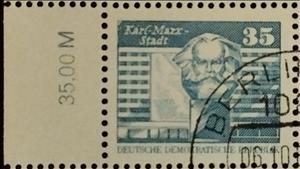Stamp with Collectible Margin: House of the State Organs, Karl-Marx-Stadt (Germany, Democratic Republic 1989)
House of the State Organs, Karl-Marx-Stadt (Germany, Democratic Republic 1989)
01 January (Germany, Democratic Republic ) within release Development in the GDR, small format goes into circulation Stamp with Collectible Margin House of the State Organs, Karl-Marx-Stadt face value 35 East German pfennig
| Stamp with Collectible Margin House of the State Organs, Karl-Marx-Stadt in catalogues | |
|---|---|
| Michel: | Mi: DD 2506wRWZII |
Stamp with Collectible Margin is horizontal format.
With sequential value label (Reihenwertzahlen)Also in the issue Development in the GDR, small format:
- Stamp with Collectible Margin - House of the State Organs, Karl-Marx-Stadt face value 2*35;
- Stamp with Collectible Margin - House of the State Organs, Karl-Marx-Stadt face value 35;
Stamp with Collectible Margin House of the State Organs, Karl-Marx-Stadt it reflects the thematic directions:
A building or edifice is a structure with a roof and walls standing more or less permanently in one place, such as a house or factory. Buildings come in a variety of sizes, shapes and functions, and have been adapted throughout history for a wide number of factors, from building materials available, to weather conditions, to land prices, ground conditions, specific uses and aesthetic reasons. Buildings serve several needs of society – primarily as shelter from weather, security, living space, privacy, to store belongings, and to comfortably live and work. A building as a shelter represents a physical division of the human habitat (a place of comfort and safety) and the outside (a place that at times may be harsh and harmful).
Communism (from Latin communis, 'common, universal') is a left-wing to far-left sociopolitical, philosophical, and economic ideology within the socialist movement, whose goal is the creation of a communist society, a socioeconomic order centered around common ownership of the means of production, distribution, and exchange that allocates products to everyone in the society based on need. A communist society would entail the absence of private property and social classes, and ultimately moneyand the state (or nation state).
Famous People refers to the fame and public attention accorded by the mass media to individuals or groups or, occasionally, animals, but is usually applied to the persons or groups of people (celebrity couples, families, etc.) themselves who receive such a status of fame and attention. Celebrity status is often associated with wealth (commonly referred to as fame and fortune), while fame often provides opportunities to make money.
A man is an adult male human. Prior to adulthood, a male human is referred to as a boy (a male child or adolescent).
A monument is a type of structure that was explicitly created to commemorate a person or event, or which has become relevant to a social group as a part of their remembrance of historic times or cultural heritage, due to its artistic, historical, political, technical or architectural importance. Examples of monuments include statues, (war) memorials, historical buildings, archaeological sites, and cultural assets. If there is a public interest in its preservation, a monument can for example be listed as a UNESCO World Heritage Site. The Palgrave Encyclopedia of Cultural Heritage and Conflict gives the next definition of monument:
In the visual arts, a cityscape (urban landscape) is an artistic representation, such as a painting, drawing, print or photograph, of the physical aspects of a city or urban area. It is the urban equivalent of a landscape. Townscape is roughly synonymous with cityscape, though it implies the same difference in urban size and density (and even modernity) implicit in the difference between the words city and town. In urban design the terms refer to the configuration of built forms and interstitial space.





